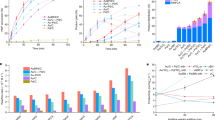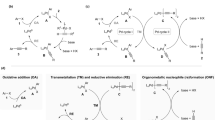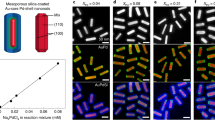Abstract
Organometallic chemistry and its applications in homogeneous catalysis have been dominated by mononuclear transition-metal complexes. The catalytic performance and physico-chemical properties of these mononuclear complexes can be rationally tuned by ligand modification, which has also led to the discovery of new reactions. There is a growing body of evidence implicating the participation of two metals in catalytic processes originally believed to follow monometallic mechanisms. Moreover, the deliberate preparation of bimetallic structures has proven popular because these preorganized structures have many tunable features, such as metal–metal bond order and polarity. These structures can exhibit metal–metal complementarity and allow for multisite activation — reactivity unattainable with truly mononuclear species. This Perspective summarizes the features that are exclusive to bimetallic systems and their roles in substrate activation.

This is a preview of subscription content, access via your institution
Access options
Access Nature and 54 other Nature Portfolio journals
Get Nature+, our best-value online-access subscription
$29.99 / 30 days
cancel any time
Subscribe to this journal
Receive 12 digital issues and online access to articles
$119.00 per year
only $9.92 per issue
Buy this article
- Purchase on Springer Link
- Instant access to full article PDF
Prices may be subject to local taxes which are calculated during checkout





Similar content being viewed by others
References
Liddle, S. T. (ed.) Molecular Metal–Metal Bonds: Compounds, Synthesis, Properties 1st edn (Wiley, 2015).
Berry, J. F. & Thomas, C. M. Multimetallic complexes: synthesis and applications. Dalton Trans. 46, 5472–5473 (2017).
Berry, J. F. & Lu, C. C. Metal–metal bonds: from fundamentals to applications. Inorg. Chem. 56, 7577–7581 (2017).
Farley, C. M. & Uyeda, C. Organic reactions enabled by catalytically active metal–metal bonds. Trends Chem. 1, 497–509 (2019).
Buchwalter, P., Rosé, J. & Braunstein, P. Multimetallic catalysis based on heterometallic complexes and clusters. Chem. Rev. 115, 28–126 (2015).
Cammarota, R. C., Clouston, L. J. & Lu, C. C. Leveraging molecular metal–support interactions for H2 and N2 activation. Coord. Chem. Rev. 334, 100–111 (2017).
Pye, D. R. & Mankad, N. P. Bimetallic catalysis for C–C and C–X coupling reactions. Chem. Sci. 8, 1705–1718 (2017).
Powers, I. G. & Uyeda, C. Metal–metal bonds in catalysis. ACS Catal. 7, 936–958 (2017).
Park, J. & Hong, S. Cooperative bimetallic catalysis in asymmetric transformations. Chem. Soc. Rev. 41, 6931–6943 (2012).
Georgiev, V. P., Mohan, P. J., DeBrincat, D. & McGrady, J. E. Low-symmetry distortions in extended metal atom chains (EMACs): origins and consequences for electron transport. Coord. Chem. Rev. 257, 290–298 (2013).
Krogman, J. P. & Thomas, C. M. Metal–metal multiple bonding in C3-symmetric bimetallic complexes of the first row transition metals. Chem. Commun. 50, 5115–5127 (2014).
Whittemore, T. J., Xue, C., Huang, J., Gallucci, J. C. & Turro, C. Single-chromophore single-molecule photocatalyst for the production of dihydrogen using low-energy light. Nat. Chem. 12, 180–185 (2020).
Feng, G. et al. Transition-metal-bridged bimetallic clusters with multiple uranium–metal bonds. Nat. Chem. 248, 248–253 (2019).
Lindahl, P. A. Metal–metal bonds in biology. J. Inorg. Biochem. 106, 172–178 (2012).
Lubitz, W., Ogata, H., Rüdiger, O. & Reijerse, E. Hydrogenases. Chem. Rev. 114, 4081–4148 (2014).
Clausen, J. & Junge, W. Detection of an intermediate of photosynthetic water oxidation. Nature 430, 480–483 (2004).
Lee, S. J., McCormick, M. S., Lippard, S. J. & Cho, U.-S. Control of substrate access to the active site in methane monooxygenase. Nature 494, 380–384 (2013).
Weigand, W. & Schollhammer, P. (eds) Bioinspired Catalysis (Wiley, 2015).
Ogo, S. et al. A functional [NiFe]hydrogenase mimic that catalyzes electron and hydride transfer from H2. Science 339, 682–684 (2013).
Schilter, D., Camara, J. M., Huynh, M. T., Hammes-Schiffer, S. & Rauchfuss, T. B. Hydrogenase enzymes and their synthetic models: the role of metal hydrides. Chem. Rev. 116, 8693–8749 (2016).
Wang, W. et al. Efficient upgrading of CO to C3 fuel using asymmetric C–C coupling active sites. Nat. Commun. 10, 5186 (2019).
Zhang, S. et al. Catalysis on singly dispersed bimetallic sites. Nat. Commun. 6, 7938 (2015).
Chen, T. & Rodionov, V. O. Controllable catalysis with nanoparticles: bimetallic alloy systems and surface adsorbates. ACS Catal. 6, 4025–4033 (2016).
Filez, M. Formation and functioning of bimetallic nanocatalysts: the power of X-ray probes. Angew. Chem. Int. Ed. 58, 13220–13230 (2019).
Goulas, K. A. et al. Synergistic effects in bimetallic palladium–copper catalysts improve selectivity in oxygenate coupling reactions. J. Am. Chem. Soc. 138, 6805–6812 (2016).
Liu, G. et al. CO2 hydrogenation to formate and formic acid by bimetallic palladium–copper hydride clusters. J. Am. Chem. Soc. 142, 7930–7936 (2020).
Monakhov, K. Y., Gourlaouen, C. & Braunstein, P. Stabilisation of a triply-bridging cyclopentadienyl ligand in a tetrapalladium cluster. Chem. Commun. 48, 8317–8319 (2012).
Liu, J. et al. Bioinspired complex–nanoparticle hybrid catalyst system for aqueous perchlorate reduction: rhenium speciation and its influence on catalyst activity. ACS Catal. 5, 511–522 (2015).
Druker, S. H. & Curtis, M. D. Activation of C–S bond homolysis by coordination to a Mo/Co/S-containing cluster. J. Am. Chem. Soc. 117, 6366–6367 (1997).
Hao, L., Xiao, J., Vittal, J. J. & Puddephatt, R. P. Models for platinum–rhenium bimetallic catalysts: sulfidation of Pt3Re clusters. Organometallics 16, 2165–2174 (1997).
Zacchini, S. Using metal carbonyl clusters to develop a molecular approach towards metal nanoparticles. Eur. J. Inorg. Chem. 2011, 4125–4145 (2011).
Pérez-Temprano, M. H., Casares, J. A., de Lera, A. R., Alvarez, R. & Espinet, P. Strong metallophilic interactions in the palladium arylation by gold aryls. Angew. Chem. Int. Ed. 51, 4917–4920 (2012).
Oeschger, R. J. & Chen, P. Structure and gas-phase thermochemistry of a Pd/Cu complex: studies on a model for transmetalation transition states. J. Am. Chem. Soc. 139, 1069–1072 (2017).
Chen, C., Hou, C., Wang, Y., Hor, T. S. A. & Weng, Z. Copper-catalyzed trifluoromethylselenolation of aryl and alkyl halides: the silver effect in transmetalation. Org. Lett. 16, 524–527 (2014).
Cotton, F. A. et al. Mononuclear and polynuclear chemistry of rhenium(iii): its pronounced homophilicity. Science 145, 1305–1307 (1964).
Nguyen, T. et al. Synthesis of a stable compound with fivefold bonding between two chromium(i) centers. Science 310, 844–847 (2005).
Frenking, G. & Tonner, R. The six-bond bound. Nature 446, 276–277 (2007).
Lyngdoh, R. H. D., Schaefer, H. F. III & King, R. B. Metal–metal (MM) bond distances and bond orders in binuclear metal complexes of the first row transition metals titanium through zinc. Chem. Rev. 118, 11626–11706 (2018).
Falvello, L. R., Foxman, B. M. & Murillo, C. A. Fitting the pieces of the puzzle: the δ bond. Inorg. Chem. 53, 9441–9456 (2014).
Schilter, D. et al. Synthesis and vibrational spectroscopy of 57Fe-labeled models of [NiFe] hydrogenase: first direct observation of a nickel–iron interaction. Chem. Commun. 50, 13469–13472 (2014).
Roos, B. O., Borin, A. C. & Gagliardi, L. Reaching the maximum multiplicity of the covalent chemical bond. Angew. Chem. Int. Ed. 46, 1469–1472 (2007).
Koritsanszky, T. S. & Coppens, P. Chemical applications of X-ray charge-density analysis. Chem. Rev. 101, 1583–1627 (2001).
Lepetit, C., Fau, P., Fajerwerg, K., Kahn, M. L. & Silvi, B. Topological analysis of the metal–metal bond: a tutorial review. Coord. Chem. Rev. 345, 150–181 (2017).
Farrugia, L. J. & Macchi, P. in Electron Density and Chemical Bonding I (ed. Stalke, D.) 127–158 (Springer, 2012).
Joy, J., Danovich, D., Kaupp, M. & Shaik, S. Covalent vs charge-shift nature of the metal–metal bond in transition metal complexes: a unified understanding. J. Am. Chem. Soc. 142, 12277–12287 (2020).
Manz, T. A. Introducing DDEC6 atomic population analysis: part 3. Comprehensive method to compute bond orders. RSC Adv. 7, 45552–45581 (2017).
Chen, H.-Z. et al. Reactions of metal–metal quintuple bonds with alkynes: [2+2+2] and [2+2] cycloadditions. Angew. Chem. Int. Ed. 51, 10342–10346 (2012).
Carrasco, M. et al. Interconversion of quadruply and quintuply bonded molybdenum complexes by reductive elimination and oxidative addition of dihydrogen. Angew. Chem. Int. Ed. 52, 3227–3231 (2013).
Chen, Y. & Sakaki, S. Mo–Mo quintuple bond is highly reactive in H–H, C–H, and O–H σ-bond cleavages because of the polarized electronic structure in transition state. Inorg. Chem. 56, 4011–4020 (2017).
Pyykkö, P. Strong closed-shell interactions in inorganic chemistry. Chem. Rev. 97, 597–636 (1997).
Gazvoda, M., Virant, M., Pinter, B. & Košmrlj, J. Mechanism of copper-free Sonogashira reaction operates through palladium–palladium transmetallation. Nat. Commun. 9, 4814 (2018).
Liang, L. & Astruc, D. The copper(i)-catalyzed alkyne–azide cycloaddition (CuAAC) “click” reaction and its applications. An overview. Coord. Chem. Rev. 255, 2933–2945 (2011).
Jin, L., Tolentino, D. R., Melaimi, M. & Bertrand, G. Isolation of bis(copper) key intermediates in Cu-catalyzed azide–alkyne “click reaction”. Sci. Adv. 1, e1500304 (2015).
Stephan, D. W. The broadening reach of frustrated Lewis pair chemistry. Science 354, aaf7229 (2016).
Welch, G. C., San Juan, R. R., Masuda, J. D. & Stephan, D. W. Reversible, metal-free hydrogen activation. Science 314, 1124–1126 (2006).
Campos, J. Dihydrogen and acetylene activation by a gold(i)/platinum(0) transition metal only frustrated Lewis pair. J. Am. Chem. Soc. 139, 2944–2947 (2017).
Hidalgo, N. et al. Evidence for genuine bimetallic frustrated Lewis pair activation of dihydrogen with gold(i)/platinum(0) systems. Chem. Eur. J. 26, 5982–5993 (2020).
Gade, L. H. Highly polar metal–metal bonds in “early–late” heterodimetallic complexes. Angew. Chem. Int. Ed. 39, 2658–2678 (2000).
Cooper, B. G., Napoline, J. W. & Thomas, C. M. Catalytic applications of early/late heterobimetallic complexes. Catal. Rev. 54, 1–40 (2012).
Mankad, N. P. Diverse bimetallic mechanisms emerging from transition metal Lewis acid/base pairs: development of co-catalysis with metal carbenes and metal carbonyl anions. Chem. Commun. 54, 1291–1302 (2018).
Bauer, J., Braunschweig, H. & Dewhurst, R. D. Metal-only Lewis pairs with transition metal Lewis bases. Chem. Rev. 112, 4329–4346 (2012).
Flynn, S. R. & Wass, D. F. Transition metal frustrated Lewis pairs. ACS Catal. 3, 2574–2581 (2013).
Bagherzadeh, S. & Mankad, N. P. Catalyst control of selectivity in CO2 reduction using a tunable heterobimetallic effect. J. Am. Chem. Soc. 137, 10898–10901 (2015).
Mazzacano, T. J. & Mankad, N. P. Base metal catalysts for photochemical C–H borylation that utilize metal–metal cooperativity. J. Am. Chem. Soc. 135, 17258–17261 (2013).
Zhou, Y.-Y. & Uyeda, C. Reductive cyclopropanations catalyzed by dinuclear nickel complexes. Angew. Chem. Int. Ed. 55, 3171–3175 (2016).
Pal, S., Zhou, Y.-Y. & Uyeda, C. Catalytic reductive vinylidene transfer reactions. J. Am. Chem. Soc. 139, 11686–11689 (2017).
Zhou, Y.-Y. & Uyeda, C. Catalytic reductive [4+1]-cycloadditions of vinylidenes and dienes. Science 363, 857–862 (2019).
Planas, O., Wang, F., Leutzsch, M. & Cornella, J. Fluorination of arylboronic esters enabled by bismuth redox catalysis. Science 367, 313–317 (2020).
Inomata, K., Watanabe, T., Miyazaki, Y. & Tobita, H. Insertion of a cationic metallogermylene into E–H bonds (E=H, B, Si). J. Am. Chem. Soc. 137, 11935–11937 (2015).
Falcone, M., Chatelain, L., Scopelliti, R., Živković, I. & Mazzanti, M. Nitrogen reduction and functionalization by a multimetallic uranium nitride complex. Nature 547, 332–335 (2017).
Robertson, S. D., Uzelac, M. & Mulvey, R. E. Alkali-metal-mediated synergistic effects in polar main group organometallic chemistry. Chem. Rev. 119, 8332–8405 (2019).
Mulvey, R. E. Avant-garde metalating agents: structural basis of alkali-metal-mediated metalation. Acc. Chem. Res. 42, 743–755 (2009).
Martínez-Martínez, A. J., Kennedy, A. R., Mulvey, R. E. & O’Hara, C. T. Directed ortho-meta′- and meta-meta′-dimetalations: a template base approach to deprotonation. Science 346, 834–837 (2014).
Deacy, A. C., Kilpatrick, A. F. R., Regoutz, A. & Williams, C. K. Understanding metal synergy in heterodinuclear catalysts for the copolymerization of CO2 and epoxides. Nat. Chem. 12, 372–380 (2020).
Hashmi, A. S. K. Gold-catalyzed organic reactions. Chem. Rev. 107, 3180–3211 (2007).
Ranieri, B., Escofeta, I. & Echavarren, A. M. Anatomy of gold catalysts: facts and myths. Org. Biomol. Chem. 13, 7103–7118 (2015).
Hicks, J., Vasko, P., Goicoechea, J. M. & Aldridge, S. Synthesis, structure and reaction chemistry of a nucleophilic aluminyl anion. Nature 557, 92–95 (2018).
Hicks, J., Mansikkamäki, A., Vasko, P., Goicoechea, J. M. & Aldridge, S. A nucleophilic gold complex. Nat. Chem. 11, 237–241 (2019).
You, D. & Gabbaï, F. P. Unmasking the catalytic activity of a platinum complex with a Lewis acidic, non-innocent antimony ligand. J. Am. Chem. Soc. 139, 6843–6846 (2017).
Cammarota, R. C. et al. A bimetallic nickel–gallium complex catalyzes CO2 hydrogenation via the intermediacy of an anionic d10 nickel hydride. J. Am. Chem. Soc. 139, 14244–14250 (2017).
Vollmer, M. V. et al. Cobalt-group 13 complexes catalyze CO2 hydrogenation via a Co(−i)/Co(i) redox cycle. ACS Catal. 10, 2459–2470 (2020).
Zhang, H. et al. Investigation of ketone C=O bond activation processes by heterobimetallic Zr/Co and Ti/Co tris(phosphinoamide) complexes. Organometallics 36, 3498–3507 (2017).
Zhang, H. et al. O2 Activation by a heterobimetallic Zr/Co complex. J. Am. Chem. Soc. 141, 9516–9520 (2019).
Kornecki, K. P. et al. Direct spectroscopic characterization of a transitory dirhodium donor–acceptor carbene complex. Science 342, 351–354 (2013).
Werlé, C., Goddard, R., Philipps, P., Farès, C. & Fürstner, A. Structures of reactive donor/acceptor and donor/donor rhodium carbenes in the solid state and their implications for catalysis. J. Am. Chem. Soc. 138, 3797–3805 (2016).
Berry, J. F. The role of three-center/four-electron bonds in superelectrophilic dirhodium carbene and nitrene catalytic intermediates. Dalton Trans. 41, 700–713 (2012).
Collins, L. R., van Gastel, M., Neese, F. & Fürstner, A. Enhanced electrophilicity of heterobimetallic Bi–Rh paddlewheel carbene complexes: a combined experimental, spectroscopic, and computational study. J. Am. Chem. Soc. 140, 13042–13055 (2018).
Liao, K. et al. Site-selective and stereoselective functionalization of unactivated C–H bonds. Nature 533, 230–234 (2016).
Liao, K. et al. Site-selective and stereoselective functionalization of non-activated tertiary C–H bonds. Nature 551, 609–613 (2017).
Acknowledgements
J.C. thanks the Spanish Ministry of Science and Education for support (project PID2019-110856GA-I00).
Author information
Authors and Affiliations
Corresponding author
Ethics declarations
Competing interests
The author declares no competing interests.
Additional information
Publisher’s note
Springer Nature remains neutral with regard to jurisdictional claims in published maps and institutional affiliations.
Rights and permissions
About this article
Cite this article
Campos, J. Bimetallic cooperation across the periodic table. Nat Rev Chem 4, 696–702 (2020). https://doi.org/10.1038/s41570-020-00226-5
Accepted:
Published:
Issue Date:
DOI: https://doi.org/10.1038/s41570-020-00226-5
This article is cited by
-
Assignment of individual structures from intermetalloid nickel gallium cluster ensembles
Communications Chemistry (2024)
-
Elucidating the reaction mechanism of a palladium-palladium dual catalytic process through kinetic studies of proposed elementary steps
Communications Chemistry (2023)
-
Geminal-atom catalysis for cross-coupling
Nature (2023)
-
Bifunctional hydroformylation on heterogeneous Rh-WOx pair site catalysts
Nature (2022)
-
Computational Study of Homogeneous Multimetallic Cooperative Catalysis
Topics in Catalysis (2022)



